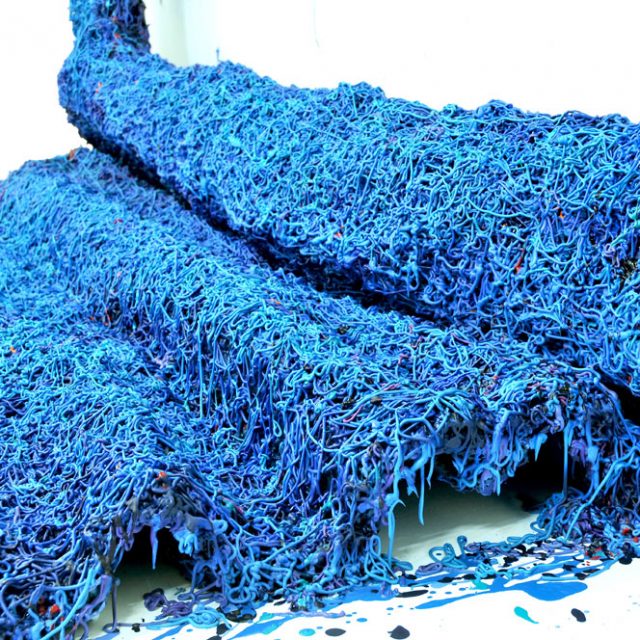Breaking Traditions in Painting

Singaporean artist Jane Lee has a great reputation for using unconventional materials and innovative techniques to push their boundaries when they are used in painting. By doing this, painting’s significance and relevance in practicing contemporary art is thoroughly investigated.
So Lee asks fundamental questions, “What is a painting? How is a painting made? How is paint applied? What happens to a painting when the paint has dried? How is a painting supported? How is a painting hung?”
By so doing, she finds that she needs more freedom and space to break free from the drastic limitations of painting to create works beyond it. So her boundary-breaking explorations of material employ a preference for method that permits experimentation and innovation.
One result is a sense of scale in Lee’s works. Another is her fondness of using good quality gels, media and other additives in paint that allowed her inventiveness to move beyond bricklayers of painterly surfaces to craft paint into 3-dimensional forms that remain vibrant and luxurious. These rich applications of paint create surfaces that are in turn tactile and organic; delicately turning her paintings’ materiality into the sculptural.
Inevitably, she displays her paintings by mounting them on the wall, the floor and even in the corners of the gallery. In so doing, the spaces in which her works are being presented are activated and themselves become her media.
Despite her deeply philosophical approach, Lee’s process in making art remains highly intuitive, crested with motifs of spontaneity and playfulness: she intensely dislikes excessive planning.
At the same time, she has a decided preference for deploying monochromatic colours, one that is primarily but enthusiastically dictated by frequent periods of happiness. She works only when she is feeling gay; striving to delight others through her art; encouraging us to immerse in the visual excitement of accepting her unique abstractions as just another convention of painting.
And Lee succeeds in this persuasion as her works are incredibly beautiful to behold: the plush, intense surfaces avoid and deter all plausible arrival at just one version of understanding her art work. Their admirers move forwards, then side ways and finally back away to catch their diverse shimmering delights.
Take her “Variations” series (2009): it is a fun-filled body of works with distinctly primeval and yet prim and proper qualities of paint-layered surfaces that reminds us of endlessly long noodles, steamy al dente pasta or crunchy chocolate chips commonly used for baking delectable cookies – all Lee faithfully recreated with pastry bags; building up near-sculptural agglomerations of acrylic paint.
Then there is Lee’s idea of cutting up a canvas to create the masterpiece “Turn Out” (2009). Here she has painstakingly cut up a long roll of canvas into long thin strips and as meticulously coiled all these ribbons from its centre. In “Turn Out II” (2010), she has the canvas painted before it was cut into ribbons and rolled into a circle and mounted on a wall. In both instances, the canvas was no longer the conventional support for a painting. It has become the focus and defining component of her creation rather than the paint.
The end result is two art pieces that resemble a hose and a reel of cord; making them infinitely more like sculpture or wall relief than painting. Yet Lee’s “Turn Out II” won the Celeste Prize in New York in 2011 under the painting category!
Lee’s installation pieces “Beyond the Blue” (2011) and “Beyond Series I” up-ended all sense of the traditional in terms of the artistic roles taken by her medium, canvas and stretcher: a large segment of the wall remained blank but for some smudging by paint and was framed by a humongous stretcher that was generously covered in stringy electric blue acrylic paint. On the floor in front of this work is a huge pile of equally stringy strands of the same said paint, making us think that her painting must have at one time groaned under its own tremendous weight before ungainly collapsing to a hefty heap on the ground!
With Lee’s “Without Canvas” (2012), the acrylic painting again depicted her characteristic meshes of hardened paint but in this case, the paint is supporting itself as she has done away with using a canvas altogether! Here, she has pastry-bag-piped acrylic paint directly on the stretcher and so formed a hollow 3-dimensional object, with the stringy strands of paint layered skein upon skein again and yet again. The end result is a painting with the heavy layers at its bottom half in dire threat of giving in to the force of gravity.
Little wonder then that she has very effectively created wondrously unique pieces of art that willfully appear to fall, unroll, hang or droop in ways that cleverly make us see them as plausible everyday objects, like a hose, a carpet and even a door.
To view, with a view to own, Jane Lee’s perceptively deceptive body of works, visit Sundaram Tagore Gallery Singapore at 9 Lock Road, #01-05 Gillman Barracks, Singapore 108933.
 Singart
Singart

One Comment on “Breaking Traditions in Painting”
It is always ok to express what you feel through art.